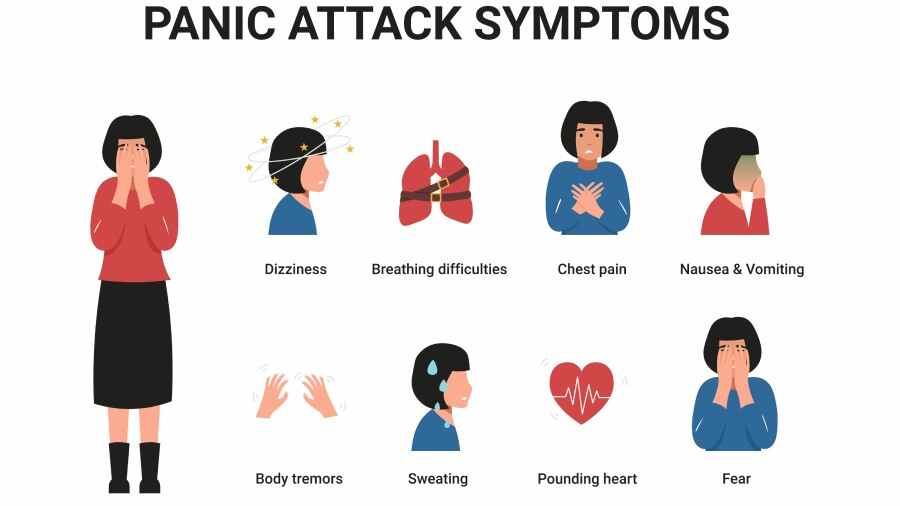Panic attack is a sudden surge of overwhelming anxiety and fear.
OR A panic attack is a sudden episode of intense fear that triggers severe physical reactions when there is no apparent causePanic Disorder is the recurrent and unexpected panic attacks and long periods in constant fear of another attack.
Cause of panic attacks
The cause of panic attack is unknown (idiopathic) but the following are thought to trigger panic attacks
- Chronic (ongoing) stress – this causes the body to produce
higher than usual levels of stress chemicals such as adrenaline. - Acute stress (such as experiencing a traumatic event) – can
suddenly flood the body with large amounts of stress chemicals. - Intense physical exercise – for some people, this may cause
extreme reactions. - Illness – may cause physical changes.
- A sudden change of environment – such as walking into an
overcrowded, hot or stuffy environment. - Physical causes like sexual abuse e.g. rape in children
- Genetic- is more frequent among relatives of patients with condition
- Personality e.g. introverts
- Stimulants e.g. use of cocaine
- Biochemical —Disturbances in neurotransmitters especially nor-adrenaline, serotonin and GABA
- Psychological —as a result of intra-psychic conflicts as a conditioned response —maladaptive learning.
- Recent life events e.g. failing of examinations
- Hypoglycemia
- Medication withdraw
- Mitral valve prolapse
- Hyperthyroidism
Signs and Symptoms of Panic Attacks
The signs and symptoms of a panic attack develop abruptly and usually reach their peak within 10 minutes.
Most panic attacks end within 20 to 30 minutes, and they rarely last more than an hour.
A full-blown panic attack includes a combination of the following
signs and symptoms:
- Heart palpitations
- Chest pain
- Sweating
- Nausea and stomach upset
- Numbness
- Anxious and irrational thinking
- A strong feeling of dread, danger or foreboding
- Fear of going mad, losing control or dying
- Feeling lightheaded and dizzy
- Tingling and chills, particularly in the arms and hands
- Trembling or shaking, sweating
- Hot flushes
- Accelerated heart rate
- A feeling of constriction in the chest
- Breathing difficulties, including shortness of breath or
hyperventilation - Tense muscles
- Dry mouth
- Feelings of unreality and detachment from the
environment.

Management of a Panic Attack
Panic attacks is psychiatric emergency that need quick action and team work
Aims of management
(a) Reducing the frequency and intensity of the panic attacks
(b) Reducing anticipatory anxiety and agoraphobic avoidance
(c) Treating co-occurring psychiatric disorders
(d) Achieving full symptomatic remission
Actual management
- The management depends on the cause of the panic attacks.
- The patient’s symptomatic status should be monitored each session such as with the use of rating scales and patients can also self monitor by keeping a daily diary of panic symptoms
- For uncomplicated panic disorder and only should be admitted if there is evidence of dangerous behavior i.e. withdraw symptoms form drugs, suicidal or homicidal ideation as they may occur in context of acute anxiety, fear of anxiety or its consequences
- Assess the risk of suicide in patient with panic disorder
- Patient’s with chest pain, dyspnea, palpitations or near syncope should be placed on oxygen and in supine or fowlers position
- Monitor the patient with pulse oximetry, electrocardiography(ECG)
- Education of the patient that their symptoms are neither from a serious medical condition nor from a psychotic disorder but rather from a chemical imbalance of fight and flight response
- Require frequent re assurance and explanation
- Provision of social services intervention which may provide supportive discussion and explore resources for outpatient care
- Cognitive behaviour therapy helps patient to understand how automatic thoughts and false beliefs/distortions lead to exaggerated emotional responses such as anxiety and can be more effective if started earlier
- Behavioral therapy involves sequentially greater exposure of the patient to anxiety provoking stimuli and over patient to anxiety provoking stimuli and overtime patient becomes desensitized
to experience relaxation techniques also help to control patients levels of anxiety. - Teach the patient respiratory training can help patient to control hyperventilation during panic and to control anxiety with controlled breathing
- Inform the patient of potential adverse reaction of specific drugs as well as a realistic time for expecting results and the likely duration of treatment.
Psychotherapy
- Explain to the patient and relatives that the symptoms are not due to any physical disease but due to mild psychological problem which can be effectively treated.
- Reassure the patient that many people have similar problems, its short lived
- Be supportive to the patient and to the relatives
- It’s important to advise the patient to reduce on alcohol and smoking because caffeine, alcohol and
nicotine are potentially anxiety producing agents.
Nursing care
- The nurse dealing with anxiety disorder patient should be careful in not allowing the patient to become dependent on the nursing staff. Too much dependence will interfere with the therapeutic relationship.
- Patients comfort and safety are nursing priorities
- In case of tensed up patients, trembling, sweating, the nurse should approach in a calm and quite environment to handle such patients.
- The nurse should educate the patient to accept the reality
- Exposure therapy —encouragement to return or remain in places of anxiety
Drug treatment
- Anxiolytics
- Educate the patient regarding the importance of long term management with selective serotonin reuptake inhibitors and the psychotherapeutic techniques
- Benzodiazepines: They can achieve long term control of panic disorder but they but they are reserved for patients with refractory panic disorder and they should not be used as monotherapy in panic disorder.
> They act quickly but carry the liability of physiologic and psychological dependence can be used
with SSRI. They use clonazepam coz it has a longer half life the alprazolam which was discouraged due to high abuse/dependence
> Lorazepam 1- 2 mg 4 hourly
> Diazepam 10- 20 mg i.v
> Clonazepam 0.5 — 2mg once daily - Antidepressants e.g.:
> Amitriptyline 25mg nocte to 50mg once daily
> Imipramine 25mg nocte - Tricyclics SSRI’S —selective serotonin reuptake inhibitors e.g.
> Fluoxetine 10 mg stat and 60 mg maintenance
> Sertraline 50mg once daily, 200mg once daily maintenance.



Thanks
We appreciate your efforts
Greatly understood 😊😊😊